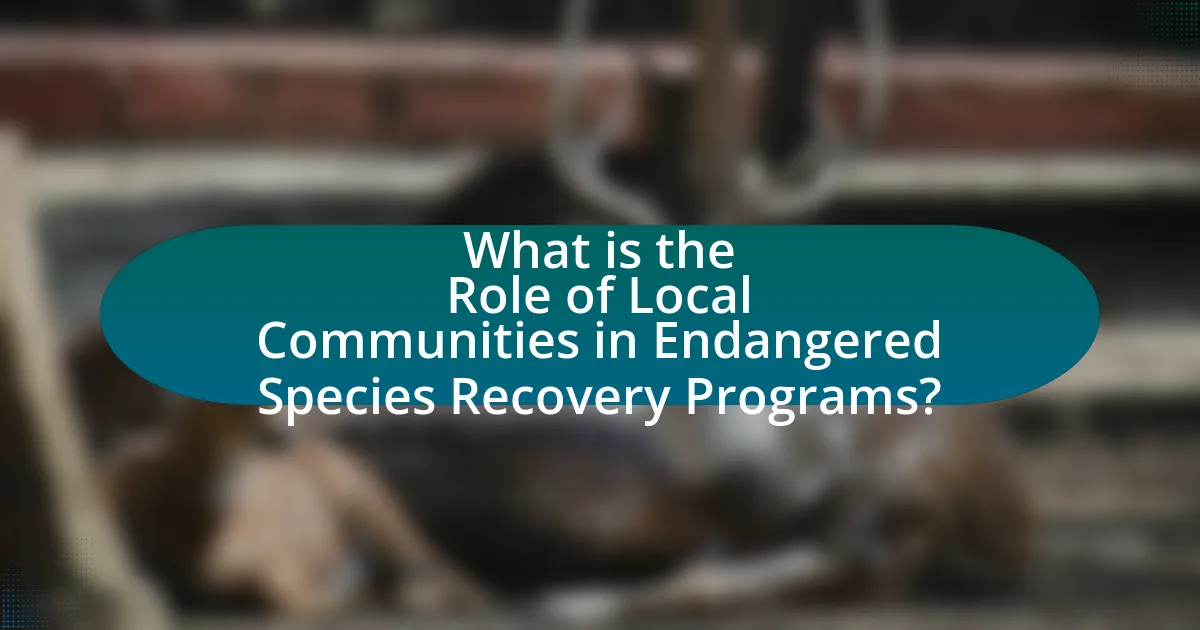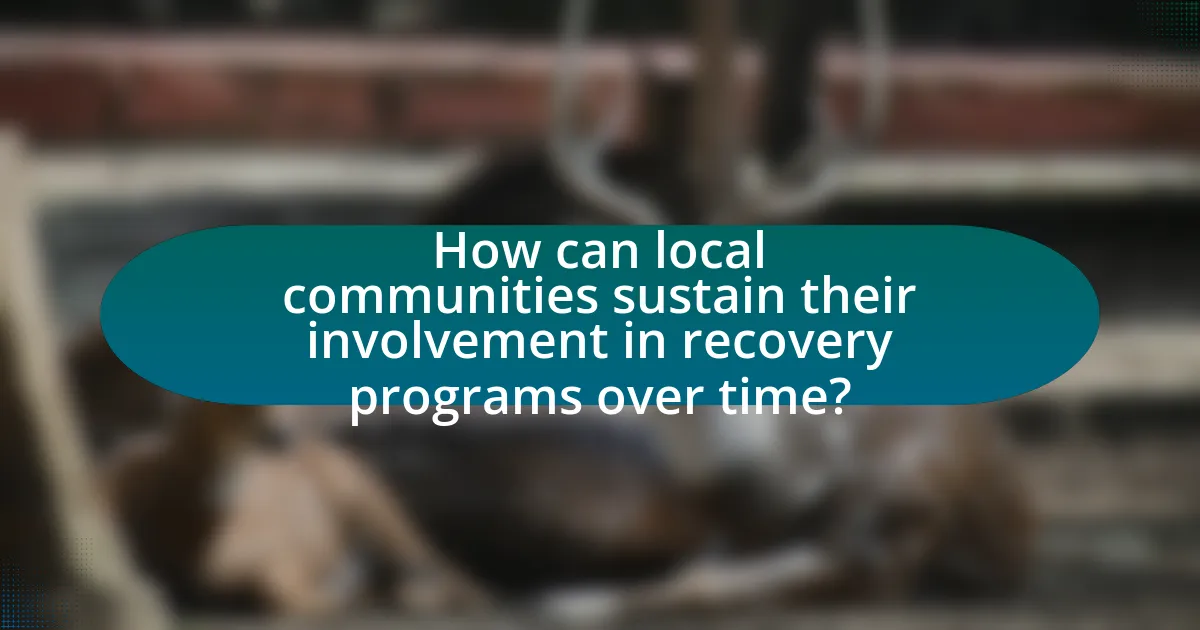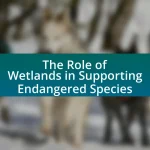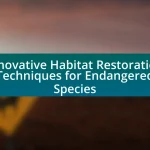Local communities are integral to endangered species recovery programs, significantly enhancing conservation efforts through active participation in habitat management and species monitoring. Their local knowledge and engagement lead to tailored conservation strategies, fostering stewardship and collaboration that improve recovery outcomes. The article explores specific actions taken by communities, such as habitat restoration and education initiatives, and highlights successful case studies like the California condor recovery. It also addresses challenges faced by communities, including socio-economic barriers and conflicts of interest, while emphasizing the importance of partnerships and adaptive management in sustaining community involvement over time.

What is the Role of Local Communities in Endangered Species Recovery Programs?
Local communities play a crucial role in endangered species recovery programs by actively participating in conservation efforts and habitat management. Their involvement often leads to increased awareness and support for biodiversity, as local residents possess valuable knowledge about the ecosystems and species in their area. For instance, community-led initiatives have been shown to enhance the effectiveness of recovery strategies, as seen in the case of the recovery of the California condor, where local stakeholders contributed to habitat protection and monitoring efforts. Additionally, studies indicate that when local communities are engaged, there is a higher likelihood of sustainable practices being adopted, which directly benefits endangered species.
How do local communities contribute to the success of recovery programs?
Local communities significantly enhance the success of recovery programs by providing local knowledge, fostering stewardship, and facilitating collaboration. Their intimate understanding of the ecosystem and species involved allows for tailored conservation strategies that are more effective. For instance, community-led initiatives often incorporate traditional ecological knowledge, which has been shown to improve habitat management and species monitoring. Additionally, when local residents are engaged in recovery efforts, they are more likely to support and participate in conservation activities, leading to increased compliance with regulations and sustainable practices. Studies have demonstrated that programs involving local communities, such as the recovery of the California condor, have seen higher success rates due to community involvement in monitoring and habitat restoration efforts.
What specific actions do local communities take in these programs?
Local communities engage in various specific actions in endangered species recovery programs, including habitat restoration, species monitoring, and community education initiatives. Habitat restoration involves local members actively participating in reforestation or wetland rehabilitation efforts to create suitable environments for endangered species. Species monitoring is conducted by community volunteers who track population numbers and health, often collaborating with researchers to gather data. Additionally, community education initiatives aim to raise awareness about the importance of conservation, leading to increased local support for recovery efforts. These actions are crucial as they leverage local knowledge and foster a sense of ownership, which has been shown to enhance the effectiveness of conservation strategies.
How do local communities influence policy decisions regarding endangered species?
Local communities influence policy decisions regarding endangered species through active participation in conservation efforts and advocacy. Their local knowledge and vested interest in biodiversity often lead to the development of grassroots movements that can sway policymakers. For instance, community-led initiatives, such as the establishment of protected areas or sustainable land-use practices, demonstrate effective local engagement that can inform and shape governmental policies. Research indicates that when local communities are involved in decision-making processes, such as in the case of the Maasai in Kenya, conservation outcomes improve, as evidenced by increased wildlife populations and habitat preservation. This involvement not only enhances the legitimacy of policies but also ensures that they are culturally relevant and more likely to be supported by the community.
Why is community involvement crucial for endangered species recovery?
Community involvement is crucial for endangered species recovery because it fosters local stewardship and enhances conservation efforts. Engaging communities ensures that conservation strategies are culturally relevant and economically viable, leading to greater local support and participation. For instance, studies have shown that when local communities are actively involved in conservation initiatives, such as the recovery of the California condor, the success rates of these programs increase significantly. This is evidenced by the fact that local stakeholders contributed to habitat restoration and monitoring efforts, resulting in a population increase from 27 individuals in 1987 to over 500 today. Thus, community involvement not only empowers local populations but also directly contributes to the effectiveness of endangered species recovery efforts.
What are the benefits of local knowledge in recovery efforts?
Local knowledge significantly enhances recovery efforts by providing insights into the specific ecological and social dynamics of the area. This knowledge allows recovery programs to tailor strategies that are culturally appropriate and environmentally effective, increasing the likelihood of success. For instance, local communities often possess historical data about species behavior, habitat conditions, and previous conservation efforts, which can inform current practices. Research has shown that integrating local knowledge with scientific approaches leads to more sustainable outcomes, as evidenced by the successful recovery of the California condor, where local input was crucial in habitat restoration efforts.
How does community engagement enhance conservation outcomes?
Community engagement enhances conservation outcomes by fostering local stewardship and increasing the effectiveness of conservation initiatives. When communities are actively involved in conservation efforts, they are more likely to support and sustain these initiatives, as evidenced by the success of programs like the Community-Based Natural Resource Management in Namibia, which led to a significant increase in wildlife populations and habitat preservation. Engaging local populations ensures that conservation strategies are culturally relevant and economically beneficial, thereby aligning conservation goals with community interests and needs. This collaborative approach not only improves compliance with conservation measures but also empowers communities to take ownership of their natural resources, leading to more sustainable and impactful conservation outcomes.
What challenges do local communities face in participating in recovery programs?
Local communities face several challenges in participating in recovery programs for endangered species, primarily including lack of resources, insufficient awareness, and conflicting interests. Limited financial and technical resources hinder community engagement and effective implementation of recovery strategies. Additionally, many community members may lack awareness of the importance of these programs, leading to low participation rates. Conflicting interests, such as economic development versus conservation, can further complicate community involvement, as stakeholders may prioritize immediate economic benefits over long-term ecological goals. These challenges are documented in studies like “Community-Based Conservation: A Review of the Literature” by Bertram and Vivier, which highlights the barriers to effective local participation in conservation efforts.
What are the socio-economic barriers to community involvement?
Socio-economic barriers to community involvement include poverty, lack of education, and limited access to resources. Poverty restricts individuals’ ability to participate in community initiatives due to financial constraints, while lack of education can hinder awareness and understanding of conservation issues. Limited access to resources, such as transportation and communication tools, further isolates communities from engagement opportunities. According to a study published in the Journal of Environmental Management, communities with higher socio-economic status are more likely to participate in conservation efforts, highlighting the correlation between socio-economic conditions and community involvement in environmental programs.
How do conflicts between conservation goals and local interests arise?
Conflicts between conservation goals and local interests arise primarily due to differing priorities and resource allocation. Local communities often depend on natural resources for their livelihoods, such as agriculture, fishing, or tourism, which may conflict with conservation efforts aimed at protecting habitats or species. For instance, the establishment of protected areas can restrict access to land and resources that local populations rely on, leading to resistance against conservation initiatives. A study by the World Wildlife Fund highlights that when local communities are not adequately involved in decision-making processes, their interests may be overlooked, exacerbating tensions between conservation objectives and local economic needs.
How can local communities be effectively engaged in recovery programs?
Local communities can be effectively engaged in recovery programs by fostering collaboration through education, participation in decision-making, and providing incentives for conservation efforts. Engaging local communities ensures that recovery programs are culturally relevant and supported by those who are directly affected. For instance, studies have shown that when local stakeholders are involved in the planning and implementation of recovery initiatives, such as the recovery of the California condor, the success rate increases significantly due to local buy-in and stewardship. Additionally, programs that offer economic benefits, such as ecotourism or sustainable resource management, motivate communities to actively participate in conservation efforts, leading to more sustainable outcomes for endangered species.
What strategies can be employed to foster community participation?
To foster community participation in endangered species recovery programs, strategies such as inclusive stakeholder engagement, education and awareness campaigns, and collaborative decision-making can be employed. Inclusive stakeholder engagement ensures that community members are actively involved in the planning and implementation of recovery initiatives, which has been shown to increase local support and investment in conservation efforts. Education and awareness campaigns raise knowledge about the importance of biodiversity and the specific species at risk, leading to greater community involvement. Collaborative decision-making allows community members to contribute their local knowledge and perspectives, enhancing the effectiveness of recovery strategies. Research indicates that programs incorporating these strategies often see higher rates of community participation and successful conservation outcomes, as evidenced by case studies in various regions where local involvement has led to improved species recovery rates.
How can education and awareness campaigns support local involvement?
Education and awareness campaigns can significantly enhance local involvement by informing communities about the importance of endangered species and the role they play in ecosystem health. These campaigns provide critical knowledge that empowers local residents to participate in conservation efforts actively. For instance, studies have shown that when communities are educated about the ecological and economic benefits of biodiversity, such as increased tourism and sustainable resource management, they are more likely to engage in protective measures. A specific example is the “Community-Based Conservation” approach, which has led to increased local stewardship in various regions, demonstrating that informed communities are more invested in the success of recovery programs.

What are the successful examples of local community involvement in recovery programs?
Successful examples of local community involvement in recovery programs include the recovery of the California condor and the red-cockaded woodpecker. In the California condor recovery program, local communities participated in habitat restoration and public education initiatives, which contributed to increasing the population from 27 individuals in 1987 to over 500 today. Similarly, the red-cockaded woodpecker recovery involved local landowners in habitat management practices, resulting in population growth from 2,000 breeding pairs in the 1970s to approximately 10,000 pairs currently. These examples demonstrate how community engagement can lead to significant conservation outcomes.
What case studies highlight effective community engagement?
Case studies that highlight effective community engagement in endangered species recovery programs include the recovery of the California condor and the red-cockaded woodpecker. In the California condor case, local communities participated in habitat restoration and educational outreach, leading to increased awareness and support for conservation efforts, which contributed to the species’ population growth from 27 individuals in 1987 to over 500 today. Similarly, the red-cockaded woodpecker recovery involved collaboration with landowners, who implemented management practices that benefited both the species and their forestry operations, resulting in population increases and habitat preservation. These examples demonstrate that community involvement is crucial for the success of conservation initiatives.
How did local communities impact the recovery of specific endangered species?
Local communities significantly impacted the recovery of specific endangered species through conservation efforts, habitat restoration, and sustainable practices. For instance, in the case of the California condor, local community involvement in breeding programs and habitat protection led to an increase in the population from 27 individuals in 1987 to over 500 by 2021. Additionally, the participation of local fishermen in the recovery of the Gulf of California’s totoaba fish, through the establishment of sustainable fishing practices, has contributed to the protection of the critically endangered vaquita porpoise by reducing bycatch. These examples illustrate how local communities play a crucial role in the recovery of endangered species by actively engaging in conservation initiatives and promoting biodiversity.
What lessons can be learned from these successful examples?
Successful examples of endangered species recovery programs demonstrate that local community involvement is crucial for sustainability and effectiveness. Engaging local communities fosters a sense of ownership and responsibility, leading to better conservation outcomes. For instance, the recovery of the California condor involved local stakeholders in habitat protection and monitoring efforts, resulting in increased population numbers from 27 individuals in 1987 to over 500 today. This illustrates that collaboration between conservationists and local residents can enhance resource management and promote biodiversity.
What role do partnerships play in enhancing community involvement?
Partnerships play a crucial role in enhancing community involvement by fostering collaboration between local stakeholders, conservation organizations, and government agencies. This collaboration leads to shared resources, knowledge, and expertise, which empower communities to actively participate in endangered species recovery efforts. For instance, the National Oceanic and Atmospheric Administration (NOAA) emphasizes that community partnerships can increase public awareness and support for conservation initiatives, ultimately leading to more effective recovery strategies. By engaging local residents in decision-making processes, partnerships also ensure that conservation efforts are culturally relevant and tailored to the specific needs of the community, thereby increasing the likelihood of successful outcomes in endangered species recovery programs.
How can collaboration between NGOs and local communities be strengthened?
Collaboration between NGOs and local communities can be strengthened by establishing transparent communication channels and fostering mutual trust. Effective communication ensures that local communities are informed about the goals and activities of NGOs, while NGOs gain insights into the needs and concerns of the communities. For instance, a study by the International Union for Conservation of Nature (IUCN) highlights that participatory approaches, where local voices are included in decision-making processes, lead to more successful conservation outcomes. Additionally, providing training and resources to local communities empowers them to actively participate in conservation efforts, thereby enhancing their commitment and collaboration with NGOs.
What are the benefits of multi-stakeholder approaches in recovery programs?
Multi-stakeholder approaches in recovery programs enhance collaboration, resource sharing, and diverse perspectives, leading to more effective conservation outcomes. These approaches facilitate the involvement of various stakeholders, including local communities, government agencies, NGOs, and researchers, which ensures that multiple viewpoints and expertise are integrated into the recovery strategies. For instance, a study published in the journal “Conservation Biology” highlights that engaging local communities in the recovery of endangered species not only improves the implementation of conservation actions but also fosters a sense of ownership and responsibility towards the species and their habitats. This collaborative framework can lead to increased funding opportunities and more sustainable practices, ultimately benefiting both the species in question and the communities involved.

How can local communities sustain their involvement in recovery programs over time?
Local communities can sustain their involvement in recovery programs over time by fostering strong partnerships, ensuring continuous education, and creating economic incentives. Strong partnerships between local communities, conservation organizations, and government agencies enhance collaboration and resource sharing, which is essential for long-term commitment. Continuous education about the ecological and economic benefits of recovery programs keeps community members informed and engaged, as seen in successful initiatives like the recovery of the California condor, where local involvement was crucial. Economic incentives, such as ecotourism or sustainable resource management, provide tangible benefits to communities, motivating them to actively participate in and support recovery efforts.
What long-term strategies can ensure continued community engagement?
Long-term strategies that can ensure continued community engagement include fostering strong partnerships, providing ongoing education, and creating inclusive decision-making processes. Strong partnerships between local communities and conservation organizations enhance trust and collaboration, which are essential for sustained engagement. Ongoing education initiatives, such as workshops and informational sessions, keep community members informed about the importance of endangered species recovery and their role in it. Additionally, inclusive decision-making processes that actively involve community members in planning and implementation foster a sense of ownership and responsibility towards conservation efforts. Research indicates that communities that feel empowered and informed are more likely to participate actively in conservation initiatives, leading to more successful recovery programs.
How can local communities build capacity for ongoing conservation efforts?
Local communities can build capacity for ongoing conservation efforts by fostering education and training programs that enhance local knowledge and skills related to biodiversity and ecosystem management. These initiatives empower community members to actively participate in conservation activities, such as habitat restoration and species monitoring. For instance, the National Oceanic and Atmospheric Administration (NOAA) has demonstrated that community-led training in marine conservation can significantly improve local stewardship and biodiversity outcomes. Additionally, establishing partnerships with conservation organizations can provide resources and expertise, further strengthening community capacity.
What funding opportunities exist to support community-led initiatives?
Funding opportunities that exist to support community-led initiatives include government grants, private foundations, and crowdfunding platforms. For instance, the U.S. Fish and Wildlife Service offers grants specifically for community-based conservation projects aimed at endangered species recovery. Additionally, organizations like the National Fish and Wildlife Foundation provide funding for local initiatives that engage communities in conservation efforts. Crowdfunding platforms such as GoFundMe and Kickstarter also allow communities to raise funds directly for their projects, enabling grassroots support. These funding sources are essential for empowering local communities to take active roles in conservation and recovery programs.
What best practices can be adopted for effective community involvement?
Effective community involvement in endangered species recovery programs can be achieved through inclusive stakeholder engagement, education initiatives, and collaborative decision-making. Engaging local communities ensures that their knowledge and perspectives are integrated into conservation strategies, which has been shown to enhance program effectiveness. For instance, the IUCN emphasizes that involving local populations leads to better compliance with conservation measures and fosters stewardship, as seen in successful projects like the recovery of the California condor, where community participation was crucial. Additionally, educational programs that raise awareness about the importance of biodiversity can empower communities to take action, as demonstrated by the success of the “Adopt-a-Species” initiatives that have increased local support for conservation efforts.
How can local communities measure the impact of their contributions?
Local communities can measure the impact of their contributions to endangered species recovery programs through specific metrics such as population monitoring, habitat restoration assessments, and community engagement surveys. For instance, tracking the population numbers of a targeted endangered species before and after community-led conservation efforts provides quantitative data on the effectiveness of those contributions. Additionally, evaluating the success of habitat restoration projects through biodiversity indices can illustrate improvements in ecosystem health. Community engagement surveys can assess local awareness and participation levels, indicating the social impact of conservation initiatives. These methods collectively offer a comprehensive view of the contributions’ effectiveness in supporting endangered species recovery.
What role does adaptive management play in sustaining community efforts?
Adaptive management plays a crucial role in sustaining community efforts by allowing for flexible decision-making based on ongoing learning and feedback. This approach enables communities to adjust their strategies in response to changing environmental conditions and stakeholder needs, thereby enhancing the effectiveness of conservation initiatives. For instance, in endangered species recovery programs, adaptive management facilitates the incorporation of new scientific data and community input, which can lead to improved outcomes and increased community engagement. Studies have shown that projects employing adaptive management are more likely to achieve their conservation goals, as they can quickly pivot and implement best practices based on real-time observations and results.


